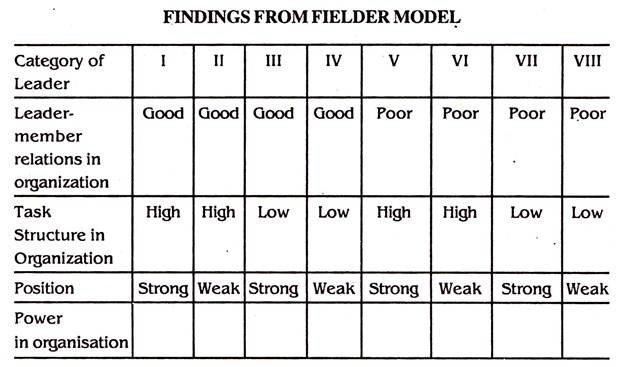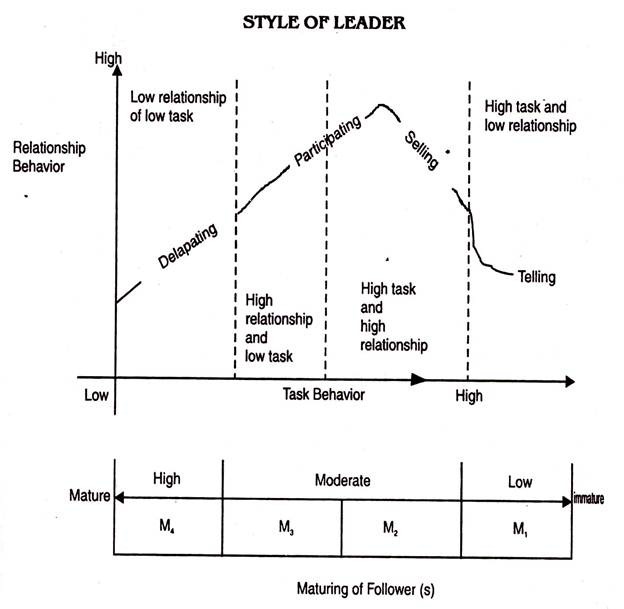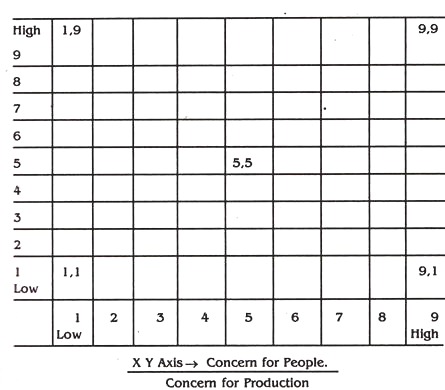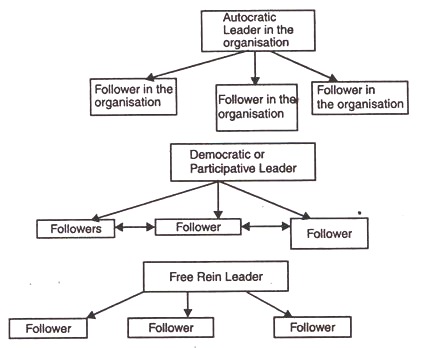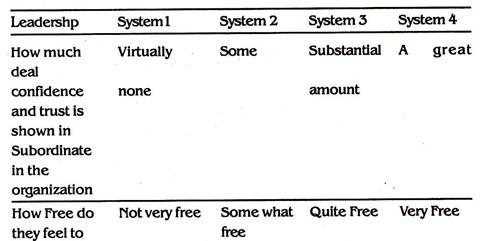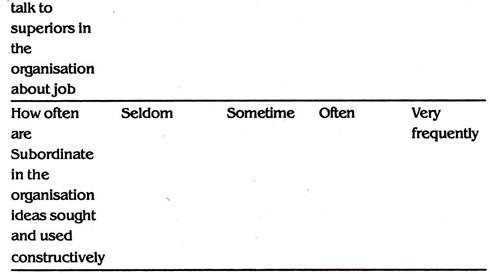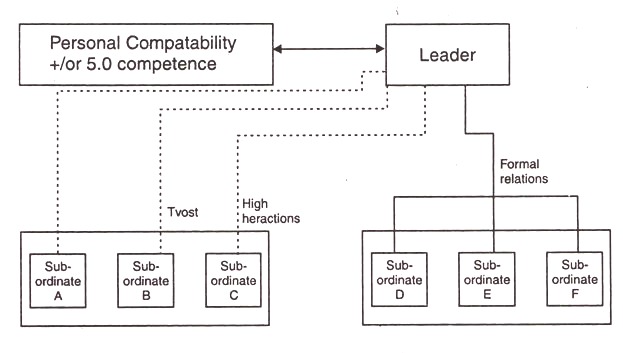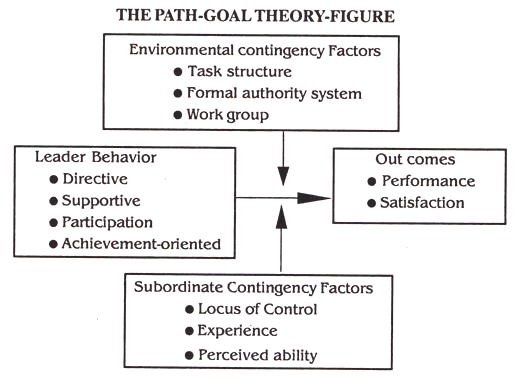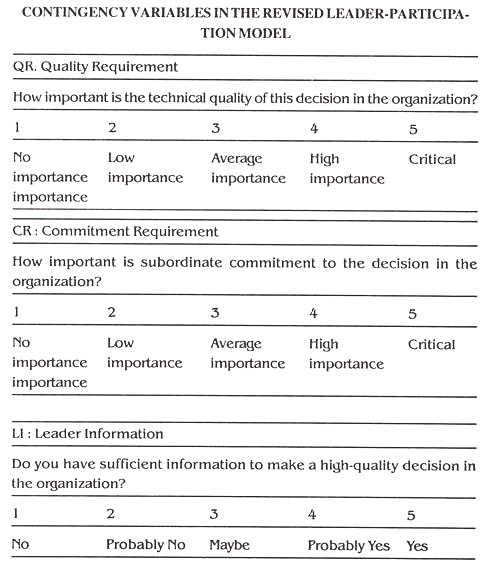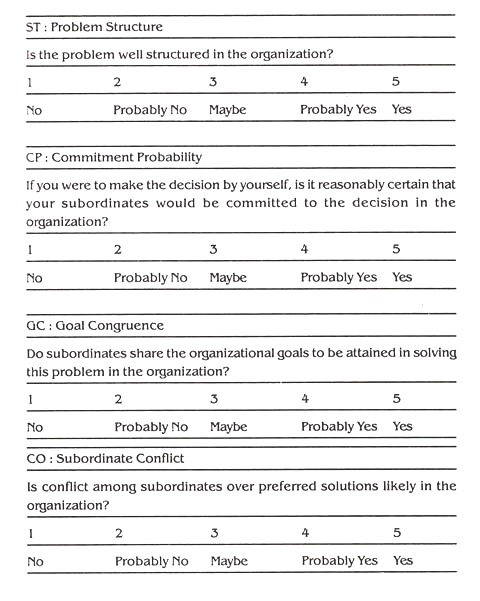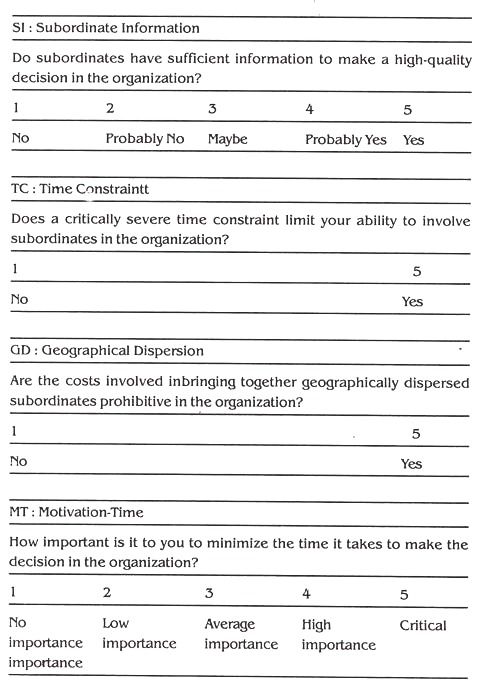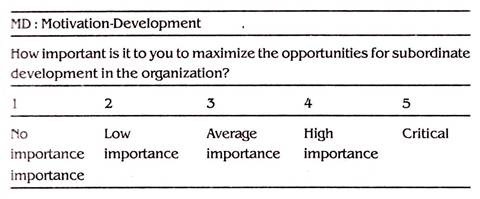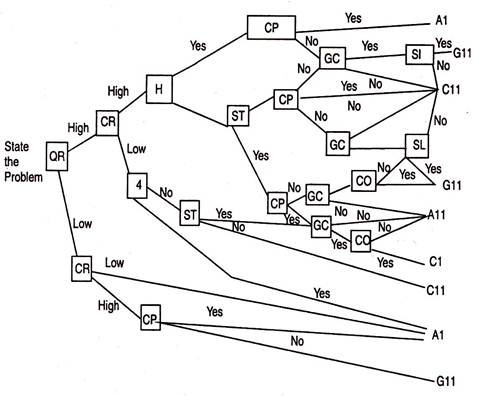This article throws light upon the top eleven theories of leadership. The theories are: 1. Trait Theories of Leadership 2. Behavioral Theories 3. Fiedler’s Contingency Theory 4. Hersey and Blanchard’s Situtational Theory 5. Managerial Grid 6. Likert’s Four Systems of Leadership 7. Leader-Member Exchange Theory 8. Path-Goal Theory 9. Leader-Participation Model 10. Attribution Theory of Leadership 11. Charismatic Leadership Theory.
1. Trait Theories of Leadership:
Today’s leader should have qualities such as intelligence, charisma, decisiveness, enthusiasm, strength, bravery, integrity, self-confidence and so on. The effective leaders should be one part Boy Scout and two parts Jesus Christ.
We acknowledge leaders who have one or more personality, social, physical or intellectual characteristics like Mahatma Gandhi, Martin Luther King, Jr., Joan of Arc, Winston Churchill, General Douglas MacArthur, John F. Kennedy, Lee Iacocca, Ted Turner, Nelson Mandela, Margaret Thatcher. These leaders have different characteristics but trait theory validity is proved if the leaders have specific characteristics.
Theories that sought personality, social, physical, or intellectual traits that differentiated leaders from non-leaders.
What traits characterize leaders like Jesse Jackson? The research has identified six: ambition and energy; the desire to lead; honesty and integrity; self-confidence; intelligence; and job relevant knowledge.
Recent research proves that people who are high self-monitors—that is, who are highly flexible in adjusting their behavior in different situations—are much more likely to emerge as leaders in groups than low self-monitors.
The correlations between specific traits and leadership have generally been in the range of +0.25 to +0.35 interesting results, but not earth-shattering. These results are based on more than 70 years of research work done by trait.
In the limitations of trait approach it overlooks the needs of followers, generally fails to clarify or clear the relative importance of various traits, doesn’t separate cause from effect (leaders self-confident or does success as a leader build self-confidence?) and ignores situational forces naturally led researchers in other directions.
2. Behavioral Theories:
Behavioral theories of leadership are theories proposing that specific behaviors differentiate leaders from non-leaders. Researchers exhibited different types of behaviors from leaders due to the inability of strike “gold” in the trait mines. Whether they tend to be more democratic than autocratic?
Behavioral Theories have more practical approach than trait theory. If trait theory is successful it will provide a basis for selecting the “right” person to assume formal positions in groups and organizations requiring leadership. In contrast if behavioral theories were to turn up critical behavioral determinants of leadership, we could train people to become best leaders in the organization.
In terms of applications Trait and Behavior all theories differs by underlying assumptions. If trait theories were valid basically, then leadership is more or less inborn: You either have it or you don’t have it. On the other hand we could design programs and teach leadership to have an infinite supply of effective leaders.
In Behavioral styles there were number of studies undertaken by researchers and the most popular one is Ohio State Group and the University of Michigan group and we shall see how the concepts that these studies developed could be used to create a grid for looking at and appraising the leadership styles.
Ohio State Studies:
The researchers of Ohio State Studies have undertaken research in the late 1940s to identify independent dimensions of leader behavior. They eventually narrowed the list into two categories that substantially for most of the leadership behavior described by subordinates and called the two dimensions as initiating structure and consideration.
Initiating Structure:
Initiating structure is one where the leader is likely to define and structure his or her role and those of subordinates in the search for goal attainment. It includes behavior that attempts to organize work, work relationships and goals in the organization.
The leader one who initiates structure could be described as “assigns group members to particular tasks”, “expects workers to maintain definite standards of performance” and “emphasizes the meeting of deadlines.”
Consideration:
Consideration is one which is described as the extent to which a person is likely to have job relationships that are characterized by mutual trust, respect for subordinates ideas, and regard for their feelings. He or She shows concern for followers’ comfort, well-being status and satisfaction.
A leader high in consideration could be described as one who helps subordinates with personal problems, is friendly and approachable, and treats all subordinates as equals in the organization.
The researchers have found based on the above definitions that “high-high” leader tended to achieve high subordinate performance and satisfaction more frequently than those who rated low on consideration, initiating structure, or both.
Mostly “high-high” style did not always result in positive consequences, for example high-high style of leader who was Characterized as high on initiating structure led to greater rates of grievances, absenteeism and turnover and lower levels of job satisfaction for workers performing routine tasks.
Other researchers argue that high consideration was negatively related to performance ratings of the leader by his or her superior. In conclusion, the Ohio State studies resulted positive outcomes, but found that situational factors needed to be integrated into the theory.
University of Michigan Studies:
University of Michigan Survey Research Center has undertaken similar study like Ohio State to locate behavioral characteristics of leaders that appeared to be related to measures of performance effectiveness in the organization. Two dimension of leadership exists namely employee-oriented and production oriented.
Employee Oriented Leadership:
Employee oriented leader will emphasize interpersonal relations; they took a personal interest in the needs of their subordinates and accepted individual differences among members.
Production-Oriented Leadership:
Production-Oriented Leadership emphasize the technical or task aspects of the job—their main concern was in accomplishing their group tasks, and the group members were means to that end in the organization.
To conclude, the Michigan researchers favoured Employee oriented type of leadership, as they were associated with higher group productivity and higher job satisfaction whereas production oriented leaders tended to be associated with low group productivity and lower job satisfaction.
3. Fiedler’s Contingency Theory:
Fred Fiedler developed the First Contingency model for leadership. Fiedlers contingency model proposes that effective group performance depends upon the proper match between the leader’s style of interacting with his or her subordinates and the degree to which the situation gives control and influence to the leader.
Fiedler developed a model which he called the least preferred co-worker (LPC) questionnaire to measure a person is task-or relationship oriented one. He isolated three situational criteria—leader membership relations, task structure, and position power-that he believes can be manipulated so as to create the proper match with the behavioral orientation of the leader.
Trait theory is outgrowth of trait theory, since the LPC questionnaire is a simple psychological test. Fiedler goes significantly beyond trait and behavioral approaches by attempting to isolate situations, relating his personality measure to his situational classification, and then predicting leadership effectiveness in organization as a function of the two.
Identifying Leadership Style:
Fiedler begins in a key factor in leadership success is the individual’s basic leadership style. So Fiedler begins by trying to find out what the basic style is and created the LPC questionnaire for this purpose, which contains sixteen contrasting adjectives such as efficient- inefficient, pleasant-unpleasant, open-guarded, supportive- hostile etc.
The questionnaire is framed by Fiedler in such a way that it will asks the respondent to think of all the coworkers they have ever had and to describe the one person they least enjoyed working with by rating him or her scale of 1 to 8 for each of the sixteen sets of contrasting adjectives.
Fiedler determines their leadership style based on LPC questionnaire, from the respondents. If the least preferred co- worker is described in relatively positive terms (a high LPC score), then the respondent is primarily interested in good personal relation with this co- worker. That is, if you essentially describe the person you are least able to work with in favourable terms in the organization.
4. Hersey and Blanchard’s Situtational Theory:
A contingency theory that focuses on follower’s maturity in the organization, this theory has been used as a major training device at such fortune 500 companies as Bank America Caterpillar, IBM, Mobil Oil and Xerox and has been accepted by many military services.
The term maturity, as defined by Hersey and Blanchard, is the ability and willingness of people to take responsibility for directing their own behavior in the organisation.
Although the theory has not undergone extensive evaluation to best its validity, we include it this because of its wide acceptance and its strong intuitive appeal, Additionally, in defense of the theory, it’s too early at this point in its development to dismiss it out of hand merely because researchers have not chosen to evaluate to more thoroughly about his research.
Situational leadership is a contingency theory that focuses on the followers who is under leader. Successful leadership is achieved by selecting the right leadership style, which is contingent on the level of the follower’s maturity. Before we proceed, we should clarify two points: why focus on the followers? What is meant by the term maturity?
The emphasis on the followers in leadership effectiveness reflects the reality that it is they who accept or reject the leader in the organisation. Regardless of what the leader does, effectiveness depends on his or her followers in the organisation. This is an important dimension that has been overlooked or underemphasized in most leadership theories which is in world.
The term maturity, is the ability and willingness of people to take responsibility for directing their own behavior in the organisation. It has two components; job maturity and psychological maturity in the organisation. The first encompasses one’s knowledge, ability, and experience to perform their job tasks without direction from others in the organisation.
Psychological maturity relates to the willingness or motivation to do something in the organisation. Individuals high in psychological maturity don’t need much external encouragement, they are already intrinsically motivated in the organization.
Situational leadership in organization uses the same two leadership dimensions that Fielder identified; task and relationship behaviors. However, Hersey and Blanchard go a step further by considering each as either high or low and then combining them into four specific leadership styles in the organization namely: telling, selling, participating and delegating.
They are described as follows:
Telling (High Task-Low Relationship):
The leader in the organization defines rules and tells subordinates, what, how, when and where to do various tasks. It emphasizes directive behavior in the organization.
Selling (High Task-High Relationship):
The leader in the organization provides both directive behavior and supportive behavior to subordinates.
Participating (Low Task-High Relationship):
The leader and follower in the organization share in decision making, with the main role of the leader being facilitating and communication in the organization.
Delegating (Low Task-Low Relationship):
The leader provides little direction or support in the organisation.
The final component in Hersey and Balanchard’s theory is defining the stages of maturity.
M1:
People in the organisation are both unable and unwilling to take responsibility to do something. They are nether competent nor confident.
M2:
People are unable but willing to do the necessary job tasks. They are motivated but currently lack the appropriate skills in the organization.
M3:
People in the organization are able but unwilling to do what the leader wants.
M4:
People are both able and willing to do what is asked to them while working in the organisation.
Figure given below indicates the various components into the situational leadership model where effective leaders should follow. As followers reach high levels of maturity, the leader responds by not only continuing to decrease control over activities, but also by continuing to decrease relationship behavior as well. At stage M1, followers need Lear and specific directions.
At stage M2, both high-task behavior compensates for the followers’ lack of ability, and the high-relationship behavior tries to get the followers psychologically to “buy into” the leader’s desires in the organisation. M3 creates motivational problems that are best solved by a supportive, non-directive, participative style in the organisation.
Finally, at stage M4, the leader doesn’t have to do much because followers are both willing and able to take responsibility in the organization.
Situational Leadership Model:
source; Adopted from P. Mersey and K. Blanchard, Management of organization Behavior: Utilising Human Resources, 4th ed., c. 1982, p. I 52, Reprinted by permission by PH, Inc. Englewood Cliffs, N.J.
The astute reader might have noticed the high similarity In between Hersey and Blanchard’s four leadership styles and four extreme “corners” in the Managerial Grid, which is discussed in this chapter. The telling style equates to the 9,1 leader; selling equals 9,9; participating is equivalent to 1,9; and delegating is the same as the 1,1 leader in the organization.
Is situational leadership, then merely the Managerial Grid with one major difference—the replacement of the 9,9 in the organization (“one style for all occasions”) contention with the recommendation that the “right” style should align with the maturity of the followers?
Hersey and Blanchard say “Mo!” They argue that the grid emphasizes concern for production and people, which are attitudinal dimensions in the organisation. Situational leadership, in contrast, emphasizes task and relationship behavior in the organisation. In spite of Hersey and Blanchard’s claim, this is a pretty minute differentiation.
Understanding of the situational leadership theory is probably enhanced by considering it as a fairly direct adoption of the grid framework to reflect four stages of follower maturity in the organization.
Finally, we come to the critical question: Is there evidence to support situational leadership theory? As noted earlier, the theory has received little attention from researchers, but on the basis of the research to date, conclusions must be guarded about this theory.
Some researchers provide partial support for theory, while others find no support for its assumptions till date. As a result, any enthusiastic endorsement should be cautioned against the theory.
5. Managerial Grid:
Blake and Mouton developed two- dimensional views in terms of graphical representation for the leadership styles. A nine by nine matrix outlining eighty- one different leadership styles based on concern for people and concern for production in the organization.
Concern for Production:
1, 1 →Impoverished Management:
Exertion of minimum effort to get required work done is appropriate to sustain organisation membership.
9, 1 →authority-Obedience:
Efficiency in operations results from arranging conditions of work in such a way that human elements interfere to a minimum degree in the organisation.
1, 9→Country Club Management :
Thoughtful attention to needs of people for satisfying relationships leads to a comfortable, friendly organisation atmosphere and work tempo in the organization.
9, 9→Team Management:
Work accomplishment is from committed people, interdependence through a ‘common stake’ in organisation purpose leads to relationships to trust and respect in the organisation.
5. 5 →Organisation Man Management:
Adequate organization performance is possible through balancing the necessity to get out work with maintaining morale of people in the organization at satisfactory level.
The findings of Blake and Mounton explains, managers in the organization were found to perform best under a 9, 9 style, contrasted, for example, with a 9,1 (authority type) or 1,9 (country club type) style. There is substantive evidence to support the conclusion that a 9,9 style is most effective in all situations in the organisation.
6. Likert’s Four Systems of Leadership:
In his early analysis of organisations, Likert (1961) clearly pointed out that despite most organisation charts showing individuals reporting to other individuals, the true nature of organization structure is a set of interlocking groups or teams variously called departments, divisions, sections, councils or committees in the organisation.
Managers in the organisation are not only responsible for individual performance, but must be able to coordinate the efforts of these several individuals where cooperation and interdependence of effort is necessary. The modified Tt group approach, now called team building, became the new tool for building collaboration into a work unit for effective leadership.
Likert’s 4 System of Management:
One influential study which demonstrated the effectiveness of this ‘power sharing’ management style in the organisation was that carried out by Renis Likert at the University of Michigan Survey Research Centre. Professor rensis Likert and his associates at the University of Michigan have studied the patterns and styles of leaders in the organization and managers for 3 decades.
In the course of his research, Likert has developed certain ideas and approaches important to understanding leadership behavior in the organisation. Likert was concerned with the characteristics of effective supervisors in the organisation. He sees an effective manager in the organisation as strongly oriented to subordinates relying on communication to keep all parties working as a unit in the organisation.
All members of the group, including the manager or leader, adopt a supportive attitude in which they share in one another’s common needs, values, aspirations, goals and expectations in the organisation.
Since it appeals to human motivations, Likert views this approach as the most effective way to lead a group. In an organization, he interviewed twenty- four supervisors and 419 clerks in highly productive and less productive departments in an American insurance company.
He found that the supervisors in the highly productive sections of the organisations were more likely to:
a) Get general as opposed to close supervision from their superiors in the organization.
b) Enjoy their job authority and responsibility in the organization.
c) Spend more time on supervision in the organization.
d) Give general as opposed to close supervision of their subordinates in the organization.
e) Be employee rather than production oriented in the organisation.
The supervisors in the sections where productivity was low had the opposite characteristics in the organisation, normally, supervisors were close, production-oriented supervisors, who concentrated on keeping their subordinates busy with specified tasks and methods and achieving targets on time in the organisation.
Likert’s effective supervisors in the organisation were not just concerned with the needs of their employees. They were seen by their subordinates as emphasising high levels of performance and achievement and had a ‘contagious enthusiasm’ for the importance of achieving these goals.
This clearly supports Fleishman’s argument that leaders need to stress both consideration and structure in the organisation. Likert and his research team at Michigan identified four main styles or system of leadership in organizations, based on their research.
As guidelines for research and for the clarification of his concepts, Likert has suggested 4 systems of management in the effective organisation.
System-I management is described as “exploitive-authoritative”; its managers are highly autocratic have little trust in subordinates, motivate people through fear and punishment and only occasional rewards, engage in downward communication and limit decision making to the top in the organization.
System 1:
Exploitative Autocratic, In Which the Leader:
a) Has no confidence and trust in subordinates in the organisation.
b) Imposes decision on subordinates in the organisation and never delegates power.
c) Motivates by threaten the subordinates.
d) Has little communication and teamwork involving subordinates in the organisation.
System 2 management is called “benevolent-authoritative”; its managers have a patronizing confidence and trust in subordinates, motivate with rewards and some fear and punishment, permit some upward communication, solicit some ideas and opinions from subordinates and allow some delegation of decision making in the organization but with close policy control.
System 2:
Benevolent Authoritative, In Which the Leader:
a) Has superficial, condescending confidence and trust in subordinates in the organisation.
b) Imposes decisions on subordinates in the organisation; never delegates.
c) Motivates by rewarding the subordinates.
d) Sometimes involves subordinates in solving problems in the organisation; paternalistic.
System 3 management is referred to as “consultative”. Managers in this system have substantial but not complete confidence and trust in subordinates, usually try to make use of subordinates’ ideas and opinions in the organisation, use rewards for motivation with occasional punishment and some participation engage in communication flow both down and up, make broad policy and general decisions at the top while allowing specific decisions to be made at lower levels and act consultatively in other ways.
System 3:
Participative, In Which the Leader:
a) Has some incomplete confidence and trust in subordinates in the organisation.
b) Listens to subordinates but controls decision-making in the organization.
c) Motivates by reward and some involvement in the organization.
d) Uses ideas and opinions of subordinates constructively in the organization.
Likert saw system 4 management as the most participative of all in the organisation and refers to it as “participative group”. System 4 managers have complete trust and confidence in subordinates in all matters; they always get ideas and opinions from subordinates and constructively use them in the organization.
They also give economics rewards on the basis of group participation in the organisation and involvement in such areas as setting goals and appraising progress towards goals. They engage in much communication down and up and with peers, encourage decision-making throughout the organization and operate among themselves and with their subordinates as a group in the organization.
System 4: Democratic, In Which the Leader:
a) Has complete confidence and trust in subordinates in the organisation.
b) Allow subordinates in the organization to make decision for them.
c) Motivates by reward for achieving goals set by participation in the organization.
d) Shares ideas and opinions in the organization.
Likert’s research shown that effective managers in the organization are those who adopt either a System 3 or System 4 leadership style in the organization, which is based on trust and pays attention to the needs of the organization and the employees. This is a difficult conclusion for some managers to accept.
The research shows, however, that democratic management means involvement, mutual respect, openness, trust, motivation and commitment in the organization. It is an ‘alternative organizational life style’, which has been found mainly in successful organization.
In general Likert found that those managers who applied the system 4 approaches to their operations had the greatest success as leaders in the organization. Moreover, he noted that departments and companies managed by the system 4 approaches were most effective in setting goals and achieving them and were generally more productive in the organization.
He ascribed this success mainly to the degree of participation and the extent to which the practice of supporting subordinates was maintained in the organization.
The Flow of Influence with 3 Leadership Styles in the Organization:
Profile of Organizational Characteristics of a new Plant Manager at a general Motor Plant by R. Likert and J.Q. Likert
7. Leader-Member Exchange Theory:
For the most part, the leadership theories we’ve covered to this point have largely assumed that leaders in the organization treat all their subordinates in the same manner. But think about your experiences in groups. Did you notice that leaders in the organization often act very differently toward different subordinates? Did the leader tend to have favorites who made up his or her “in” group?
If you answered “Yes” to both these questions, you’re acknowledging what George Graen and his associates have observed, which creates the foundation for their leader-member exchange theory in the organization (recently renamed from the vertical dyad linkage theory).
Leader-Member Exchange Theory (LMX):
The leader-member exchange (LMX) theory argues that because of time pressures leaders establish a special relationship with a small group of their subordinates in the organization. These individuals make up the in group they .ire trusted, get a disproportionate amount of the leader’s attention, and are more likely to receive special privileges.
Other subordinates fall into the out-group in the organization. They get less of the leader’s time, fewer of the preferred rewards that the leader controls, and have superior- subordinate relations based on formal authority interactions.
The theory proposes that early in the history of the interaction between a leader in the organization and a given subordinate, the leader implicitly categorizes the subordinate .is an “in” or an “out” and that relationship is relatively stable over time.
Just precisely how the leader chooses who falls into each category is unclear, but there is evidence that leaders in the organization tend to choose in-group members because that have personal characteristics (for example age, sex, personality) that are compatible with the leader and/or a higher level of competence than out-group members (see figure above).
LMX theory predicts that subordinates in the organization with in-group status will have higher performance ratings, less turnover, and greater satisfaction with their superior.
Research to test LMX theory has been generally supportive in the organization. More specially, the theory and research surrounding it provide substantive evidence that leaders in the organization do differentiate among subordinates, that these disparities are far from random, and that in-group and out-group status are related to employee performance and satisfaction.
8. Path-Goal Theory:
Currently, one of the most respected approaches to leadership in the organization is the path-goal theory. Developed by Robert House, path-goal theory is a contingency model of leadership that extracts key elements from the Ohio State Leadership research on initiating structure and consideration and the expectancy theory of motivation in the organization.
The essence of the theory is that it’s the leader job to assist his or her followers in attaining their goals and to provide the necessary direction and/or support to ensure that their goals are compatible with the overall objectives of the group or organisation as a whole.
The term “path-goal” is derived from the belief that effective leaders clarify the path to help their followers get from where they are to the achievement of their work goals and make the journey along the path easier by reducing roadblocks and pitfalls in the organization.
According to path-goal theory in the organization, a leader’s behavior is acceptable to subordinates to the degree that they view it as an immediate source of satisfaction or as a means of future satisfaction.
A leader’s behavior is motivational to the degree that it:
(i) Make subordinate need satisfaction contingent on effective performance and
(ii) Provides the coaching, guidance support, and rewards that are necessary for effective performance.
To test these statements in the organization, House identified four leadership behaviors.
The directive leader lets subordinates know what is expected of them in the organization, schedules work to be done, and gives specific guidance as to how to accomplish tasks. This closely parallels the Ohio State dimension of initiating structure in the organization.
The supportive leader is friendly and shows concern for the needs of subordinates in the organization. This is essentially synonymous with the Ohio State dimension of consideration.
The participative leader consults with subordinates and uses their suggestions before making a decision in the organization. The achievement-oriented leader sets challenging goals and expects subordinates to perform at their highest level. In contrast to Fielder’s view of a leader’s behavior, House assumes that leaders are flexible in the organization.
Path- goal theory implies that the same leader can display any or all of these behaviors depending on the situation in the organization.
The figure illustrates, path-goal theory proposes two classes of situational or contingency variables that moderate the leadership behavior outcome relationship those in the environment that are outside the control of the subordinate (task structure, the formal authority system, and the work group) and those that are part of the personal characteristics of the subordinate in the organization (locus of control, experience, and perceived ability).
Environmental factors determine the type of leader behavior required as a complement if subordinate outcomes are to be maximized, while personal characteristics of the subordinates determine how the environment and leader behavior are interpreted in the organization.
So the theory proposed that leader behavior will be ineffective when it is redundant with sources of environmental structure or incongruent with subordinate characteristics in the organization.
The following are some examples of hypotheses that have evolved out of the path-goal theory in the organization:
a) Directive leadership in the organization leads to greater satisfaction when tasks are ambiguous or stressful than when they are highly structured and well laid out.
b) Supportive leadership in the organization results in high employee performance and satisfaction when subordinates are performing structured tasks.
c) Directive leadership in the organization is likely to be perceived as redundant among subordinates with high-perceived ability or with considerable experience.
d) The more clear and bureaucratic the formal authority relationships, the more leaders should exhibit supportive behavior and de-emphasize directive behavior in the organization.
e) Directive leadership in the organization will lead to higher employee satisfaction when there is substantive conflict within a work group.
f) Subordinates in the organization with an internal locus of control (those who believe they control their own destiny) will be more satisfied with a participative style.
g) Subordinates with an external locus of control will be more satisfied with a directive style in the organization.
h) Achievement-oriented leadership will increase subordinates’ expectancies that effort will lead to high performance when tasks are ambiguously structured in the organization.
Research to validate hypotheses such as these is generally encouraging in the organization. The evidence supports the logic underlying the theory. That is, employee performance and satisfaction are likely to be positively influenced when the leader compensates for things lacking in either the employee or the work setting in the organization.
However, the leader who spends time explaining tasks when those tasks .ire already clear or when the employee has the ability and experience to handle them without interference is likely to be ineffective because the employee will see such directive behavior as redundant or even insulting in the organization.
What does the future hold for path-goal theory? Its framework has been tested and appears to have moderate to high empirical support in the organization. We can, however, expect to see more research focused on refining and extending the theory by incorporating additional moderating variables in the organization.
9. Leader-Participation Model:
Leader-Participation Model is leadership theory that provides a set of rules to determine the form and amount of participative decision-making in different situations in the organization. Back in 1973, Victor Vroom and Phillip Yetton developed a leader-participation model that related leadership behavior and participation to decision making in the organization.
Recognizing that task structures have varying demands for routine and non-routine activities, these i« searchers argued that leader behavior must adjust to reflect the task structure in the organization.
Vroom and Yetton’s model was normative—it provided a sequential set of rules that should be followed for determining the form and amount of participation desirable in decision making, as dictated by different types of situations in the organization.
The model was a complex decision tree incorporating seven contingencies (whose relevance could be identified by making “yes” or “no” choices) and five alternative leadership styles.
More recent work by Vroom and Arthur Jago has resulted in a revision of this model without any barrier. The new model retains the same five alternative leadership styles but expands the contingency variables to twelve, ten of which are answered along a five-point scale. Table given below lists the twelve variables.
The model assumes that any of five behaviors may be feasible in a given situation in the organization—Autocratic I (AI), Autocratic II (All), Consultative I (CI), Consultative II (CII) and Group II (Gil):
AI:
You solve the problem or make a decision yourself using information available to you at that time in the organization.
AH:
You obtain the necessary information from subordinates in the organization and then decide on the solution to the problem yourself. You may or may not tell subordinates what the problem is when getting the information from them.
The role played by your subordinates in making the decision is clearly one of providing the necessary information in the organization to you rather than generating or evaluating alternative solutions.
CI:
You share the problem with relevant subordinates individually, getting their ideas and suggestions without bringing them together as a group. Then you make the decision, which may or may not reflect subordinates’ influence in the organization.
CII:
You share the problem with your subordinates as a group, collectively obtaining their ideas and suggestions. Then you make the decision that may or may not reflect you subordinates’ influence in the organization.
Gill:
You share the problem with your subordinates as a group. Together you generate and evaluate alternatives and attempt to reach an agreement (consensus) on a solution. Vroom and Jago have developed a computer program that cuts through the complexity of the new model in the organization.
But managers can still use decision trees to select their leader style if there are no “shades of gray” (that is, when the status of a variable is clear-cut so that a “Yes” or No” response will be accurate), there are not critically severe lime constraints, and subordinates are not geographically dispersed. Figure given below illustrates one of these decision trees.
Research testing of the original leader-participation model was very encouraging. Because the revised model is new, its validity still needs to be assessed. But the new model is a direct extension of the 1973 version and it’s also consistent with our current knowledge of the benefits and costs of participation.
So, at this time, we have every reason to believe that the revised model provides an excellent guide to help managers choose the most appropriate leadership style in different situations.
Two last points before we move on. First, the revised leader participation model is very sophisticated and complex, which makes it impossible to describe in detail in a basic OB text book. But the variables identified in the table of managerial grid provide you with some solid insights about which contingency variables you need to consider when choosing your leadership style.
Second, the leader-participation model confirms that leadership research should be directed at the situation rather than the person. It probably makes more sense to talk about autocratic and participative situations than about autocratic and participative leaders.
As did House in his path-goal theory, Vroom, Yetton, and Jago argue against the nation that leader behavior is inflexible. The leader-participation model assumes that the leader can adjust his or her style to different situations.
Contingency Variables in the Revised Leader-Participation Model:
QR-Quality Requirement:
How important is the technical quality of this decision in the organization?
CR-Commitment Requirement:
How important is subordinate commitment to the decision in the organization?
LI-Leader’s Information:
Do you have sufficient information to make a high-quality decision in the organization?
ST-Problem Structure:
Is the problem well-structured in the organization?
CP-Commitment Probability:
If you were to make the decision by yourself, is it reasonably certain that you subordinate(s) would be committed to the decision?
GC-Goal Congruence:
Do subordinates share the organizational goals to be attained in solving this problem in I lie organization?
CO-Subordinate Conflict:
Is conflict among subordinates over preferred solutions likely in the organization?
Si-Subordinate Information:
Do subordinates have sufficient information to make a high-quality decision in the organization?
10. Attribution Theory of Leadership:
Attribution theory has also been used to help explain the perception of leadership in the organization. Attribution theory as you remember, deals with people trying to make sense out of cause-effect relationships in the organization.
When something happens, they want to attribute it to something. In the context of leadership, attribution theory says that leadership in the organization is merely an attribution that people make about other individuals.
Using the attribution framework, researchers have found that people characterize leaders as having such traits as intelligence, outgoing personality, strong verbal skills, aggressiveness, understanding, and industriousness.
Similarly, the high-high leader (high on both initiating structure and consideration) has been found to be consistent with attributions of what makes a good leader in the organization.
That is, regardless of the situation, a high- high leadership style tends to be perceived as best. At the organizational level, the attribution framework accounts for the conditions under which people use leadership to explain organizational outcomes.
Those conditions are extremes in organizational performance in the organization. When an organization has either extremely negative or extremely positive performance, people are prone to make leadership attributions to explain the performance. When an organization has either extremely negative or extremely positive performance, people are prone to make leadership attributions to explain the performance.
This helps to account for the vulnerability of CEOs when their organizations suffered a major financial setback, regardless of whether they had much to do with it. It also accounts for why these CEOs tend to be given credit for extremely positive financial results— again, regardless of how little they contributed in the organization.
One of the more interesting themes in the attribution theory of leadership literature is the perception that effective leaders are generally considered consistent or unwavering in their decisions in the organization.
That is, one of the explanations for why Lee Iacocca and Ronald Reagan (during his first term as President) were perceived as leaders that both were fully committed, steadfast, and consistent in the decisions they made and the goals they set the in organization.
Evidence indicates that a “heroic” leader perceived as being someone who takes up a difficult or unpopular cause and through determination and persistence., ultimately succeeds in the organization.
11. Charismatic Leadership Theory:
It says that followers in the organization make attributions of herroic or extraordinary leadership abilities when they observe certain behaviors Studies on charismatic leadership have, for the most part, been directed at identifying those behaviors that differentiate charismatic leaders—the Jesse Jacksons, Ted Turners, and John, F. Kennedys of the world—from their non-charismatic counterparts.
Several authors have attempted to identify personal characteristics of the charismatic leader in the organization. Robert House (of path-goal fame) has identified three: extremely high confidence, dominance, and strong convictions in his or her beliefs in the organization.
Warren Bennis, after studying ninety of the most effective and successful leaders in the United States, found that they had four common competencies:
They had a compelling vision or sense of purpose; they could communicate that vision in clear terms that their followers could readily identify with; they demonstrated consistency and focus in the pursuit of their vision; and they knew their own strengths and capitalized on them in the organization.
The most recent and comprehensive analysis, however has been completed by Conger and Kanungo at McGill University.
Among their conclusions, they propose that charismatic leaders have an idealized goal that they want to achieve, a strong personal commitment to their goal, are perceived as unconventional, are assertive and self-confident, and are perceived as agents of radical change rather than managers of the status quo in the organization.
The table given below summarizes the key characteristics that appear to differentiate charismatic leaders from non-charismatic ones. 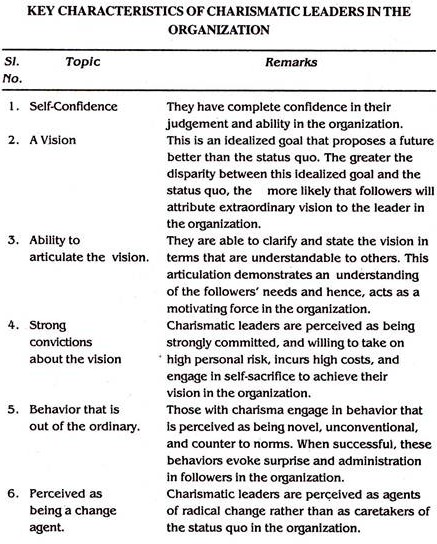
What can we say about the charismatic leader’s effect on his or her followers in the organization? There is an increasing body of research that shows impressive correlations between charismatic leadership and high performance and satisfaction among followers in the organization.
People working for charismatic leaders are motivated to exert extra work effort and, because they like their leader, express greater satisfaction in the organization.
If charisma is desirable, can people learn to be charismatic leaders in the organization? Or are charismatic leaders born with their qualities? While a small minority still thinks charisma cannot be learned, most experts believe that individuals can be trained to exhibit charismatic behaviors and can thus enjoy the benefits that accrue to being labelled “a charismatic leader” in the organization.
For example researchers have succeeded in actually scripting undergraduate business students to “play” charismatic in the organization.
The students were taught to articulate an overarching goal, communicate high performance expectations, exhibit confidence in the ability of subordinates to meet these expectations, and empathize with the needs of their subordinates; they learned to project a powerful, confident and dynamic presence; and they practices using a captivating and engaging voice tone in the organization.
To further capture the dynamics and energy of charisma, the leaders were trained to evoke charismatic non-verbal characteristics: They alternated between pacing and sitting on the edges of their desks, leaned toward the subordinate, maintained direct eye contact, and had a relaxed posture and animated facial expressions in the organization.
These researchers found that these students could learn how to project charisma. Moreover, subordinates of these leaders had higher task performance, tasks adjustment, and adjustment to the leader and to the group than did subordinates who worked under groups led by non-charismatic leaders in the organization.
One Last Word on this Topic:
Charismatic leadership in the organization may not always be needed to achieve high levels of employee performance. It may be most appropriate when the follower’s tasks have an ideological component in the organization.
This may explain why, when charismatic leaders surface, it is more likely to be in politics, religion, wartime, or when a business firm is introducing a radically new product or facing a life-threatening crisis in the organization. Such conditions tend to involve ideological concerns in the organization.
Franklin D. Roosevelt offered a vision to get Americans out of the Great Depression. General MacArthur was unyielding in promoting this strategy for defeating the Japanese in World War II.
Steve Jobs achieved unwavering loyalty and commitment from the technical staff he oversaw at Apple computer during the late 1970s and early 1980s by articulating a vision of personal computers that would dramatically change subside.
Why? Because then (he charismatic leader’s in the organization overwhelming self- confidence often becomes a liability. He or she in the organization is unable to listen to others, becomes uncomfortable when challenged by aggressive subordinates, and begins to hold an unjustifiable belief in his or her ‘rightness’ on issues.
